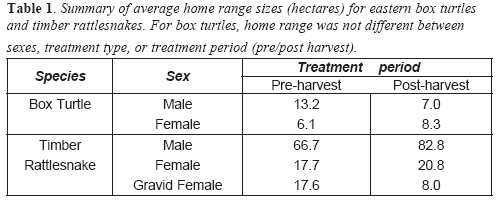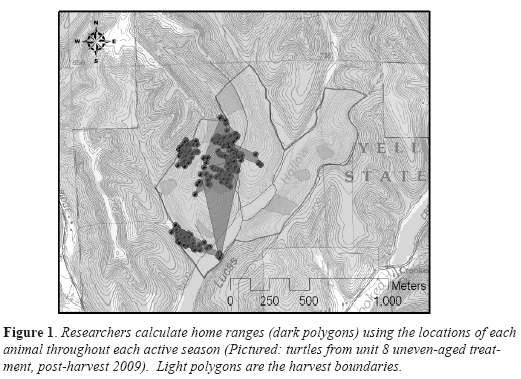Fall 2010 Volume 19 No. 3
The Hardwood Ecosystem Experiment - Part 2
By Brian MacGowan In Part 1 of this feature (The Woodland Steward, Volume 19 No. 2), I described the role of disturbance and early successional habitats in our Central Hardwood Forests, how timber harvesting can mimic natural disturbance, and the design and role of the Hardwood Ecosystem Experiment (HEE) in understanding the ecological and social impacts of forest management. Part 2 features details of various aspects of the project with some preliminary results. • Forest Dynamics (Michael Saunders, Purdue University) - Over 700 quarter-acre plots have been established across units. Stands average 44.5 oak trees per acre, but only 7.0 oak saplings per acre. • Oak Mast (Robert Swihart, Purdue University) - Four types of semi-permeable exclosures (open, deer, squirrel, mouse) partition acorn use by seed predators. So far, mice are the largest mast users, but use is variable from year to year. Acorns were also x-rayed for weevil infestation which varied from 20-40% each year. • Birds Communities (John Dunning, Jr., Purdue University) - Annual surveys since the start of the project have shown more than 60 species of native birds breed in the HEE study regions. In 2009 (the first year after the timber harvests), several species of birds that use early successional habitat increased markedly from previous years. These birds, which include Eastern Towhees and Indigo Buntings, are rarely part of active management programs on public lands (which tend to concentrate on protecting older forests) so the HEE project should provide information on how a wide array of bird species can be accommodated through timber management. • Cerulean Warblers (Kamal Islam, Ball State University) - Territory size and abundance of Cerulean Warblers, an endangered species in Indiana, was estimated by point counts and mapping each study area. Average territory size was 0.65 ac and density was 18.1 males per square mile in 2007. • Wood Boring and Longhorn Beetles (Jeff Holland, Purdue University) - Jeff and his students are looking at changes at different spatial scales in the community of longhorned beetles across forestry treatments. Over 100 species of longhorn beetles across project sites. Species have shown different responses depending on the diverse behaviors of these beetles. • Moths (Keith Summerville, Drake University) - Moths play a prominent though often overlooked role in forest health (through their feeding on tree leaves and for potential defoliating effects) and biodiversity (by serving as bird food / small mammal food). Moths respond to disturbance well before larger vertebrates with bigger home ranges tend to experience environmental stress. Thus, moths make a good early warning system for foresters when understanding short- and long-term changes in managed stands. • Small Mammals (Robert Swihart, Purdue University) - Sherman live and pitfall traps were used to sample small mammal communities. A total of 3,381 captures of 8 species were made across all units with no strong differences among sites. White-footed mouse, eastern chipmunk, and pine vole were the most commonly captured species. • Bats (John Whitaker, Indiana State University) - Mist nets and acoustic sampling were used to record bat use on sites. Eight species of bats were captured on HEE sites. The northern myotis, eastern red bat and big brown bat made up 86% of all captures. • Salamanders (Rod Williams, Purdue University) - Monitored populations biannually with 84 cover object grids (30, 1-sqft boards) and annually with plot searches. Over 12,000 captures of nine species have been recorded from 2007-2009. • Human Dimensions (Bill Hoover and Shannon Amberg, Purdue University) - A survey of local forest users and surrounding landowners was conducted in 2007 to determine peoples’ values and attitudes regarding the management of public forests. Clearcuts were disliked and practices that resulted in higher stand density were preferred. Research Highlight Eastern box turtles and timber rattlesnakes, species of conservation concern in Indiana, were located within the study sites and subsequently released at the capture site after radio transmitters were attached. In 2007-2010, a total of 42 rattlesnake and 50 box turtles were tracked to find out movements and habitat use (Figure 1). Our goal was to investigate use of harvest areas by these species, and find out if timber harvesting caused changes in home range and/or habitat use by these species.With only one year of post-harvest data analyzed, conclusions should be made with caution. However, our results indicate that timber harvesting does not affect home range and summer habitat use for either species in the short-term. Average home range sizes for both species did not differ among treatments (control, even-aged tree harvest, and even-aged tree harvest) either before or after timber harvesting (Table 1). In fact, the increase in ground-level vegetation and downed woody debris resulting from harvests may actually improve habitat for these species. These questions will be answered as the project progresses. Brian MacGowan is an Extension Wildlife Specialist with Purdue University’s Department of Forestry and Natural Resources and studies box turtles and timber rattlesnakes on the Hardwood Ecosystem Experiment.

